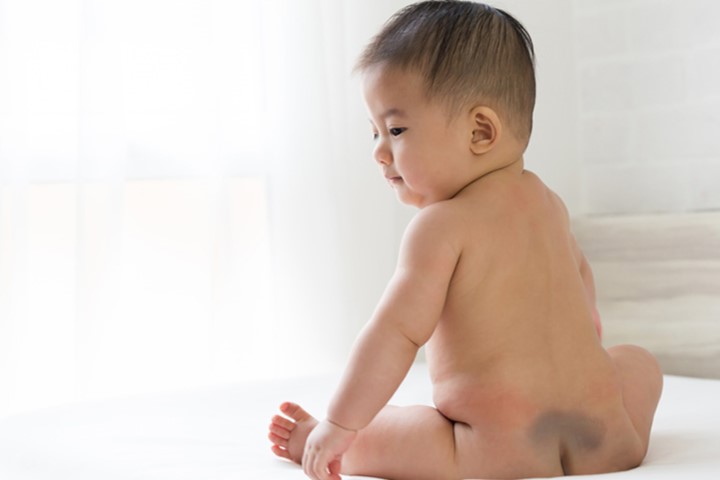Birthmarks are common in newborns, they can be concerning to parents and children due to their shape, size, color or site. Mongolian spots any types of birthmarks seen in newborns. Read further to understand their causes, prevalence, prognosis and treatment.
In This Article:
- What are Mongolian Spots and How to Identify them?
- What Causes Mongolian Spots?
- Prevalence of Mongolian Spots
- Prognosis of Mongolian Spots
- Risks Associated with Mongolian Spots
- Treatment of Mongolian Spots
- Mongolian Spots – When to be Concerned and Seek Medical Care?
All You Need to Know about Mongolian Spots in Babies
What are Mongolian Spots and How to Identify them?
Mongolian spots are also known as Slate grey nevi or congenital dermal melanocytosis. They are bluish-green to grey spots found mostly on lower back or buttocks, less frequently on arms and legs. They disappear spontaneously within 1-4 years of birth but can persist for life.
Identification of Mongolian Spots in Infants
Because of the similar appearance and bluish colouration, Mongolian spots can be mistaken for normal birthmarks or bruises. Bruises are painful and disappear within a matter of few days whereas Mongolian spots are not painful and disappear within years.
Features of Mongolian spots are
- They are flat against the skin, with normal skin texture.
- Blue or bluish-grey in color.
- Usually 2-8 centimetres in width.
- Have an irregular shape, with poorly distinguished edges.
- Usually present at birth or soon after.
- Usually located on buttocks or lower back and less commonly on trunks or extremities.
It’s important to understand the common characteristics of Mongolian spots. Marks aren’t related to Mongolian spots if
- If they are raised, because Mongolian spots aren’t raised, they are flat.
- If they aren’t bluish in color.
- Appear later in life.
What Causes Mongolian Spots?
Mongolian spots are a congenital developmental condition. It is caused by the trapping of melanocytes ( cross which produce melanin pigment which gives our skin colour) in dermis during their migration from the neural crest cells into epidermis during pregnancy. Epidermis is the uppermost layer of skin whereas dermis is the layer just beneath it. These spots appear bluish in color due to deep embedded melanocytes which leads to Tyndall effect of scattered light, appearing bluish.
Prevalence of Mongolian Spots
The prevalence of Mongolian spots varies accordingly in different ethnic groups. It is more prevalent in dark coloured individuals due to abundance of melanocytes in them. Most commonly seen in Asians, around 90% of them have it. 80% East-Africans have been reported to have Mongolian spots, 46% Hispanic children and 1-9% white children. Mongolian spots have no sex predilection, i.e it occurs equally in boys and girls.
Prognosis of Mongolian Spots
These spots usually fade within the first year of life, but may persist throughout life in some cases. Mongolian spots on sites other than lower back and buttocks have lower chances of resolution. In a study it was found that Mongolian spots larger than 10 cm in size are likely to persist beyond one year of life.
Risks Associated with Mongolian Spots
Mongolian spots are typically harmless but may pose the risk of several inborn metabolic disorders in rare cases. These cases usually have extra-sacral spots or spots large in size.
- Hurler’s disease
- Hunter’s syndrome
- Niemann- Pick disease
- Mucolipidosis
- Mannosidosis
These disorders could be related to Mongolian spots but due to their rarity and lack of research in the field, the link between them cannot be established.
Treatment of Mongolian Spots
Mongolian spots usually disappear within 1-4 years of birth and do not require any medical treatment. Also they are not painful and usually are present at lower back and buttocks, hidden from sight, posing no significant concerns.
However if they persist later on in life and are a cause of embarrassment to the child or parents, medical care can be sought. Mongolian spots can be treated in two ways :-
- Medical care – through the use of opaque cosmetics, these spots can be hidden using camouflage.
- Surgical care- Lasers have progressed the treatment of Mongolian spots to a certain extent but the results are very uncertain. In a study conducted using Q- switched alexandrite laser for the treatment had better outcomes if the patient was younger than 20 years. The treatment was more if the spots were in exposed body parts rather than non-exposed parts.
Mongolian Spots – When to be Concerned and Seek Medical Care ?
Mongolian spots are common among certain ethnic groups, but most of them fade away within few years and pose no risks to the health of the individual. However they should be observed for changes in shape, color and size. Any significant change should be consulted to a dermatologist.
Also Mongolian spots can be confused for bruises and can be taken for false signs of child abuse and lead to uninvited consequences and complications. So it’s better to take photographs of these spots from birth and keep on recording changes at regular intervals. These photographs can be helpful to avoid misunderstandings.
References
https://emedicine.medscape.com/article/1068732-treatment#d8
